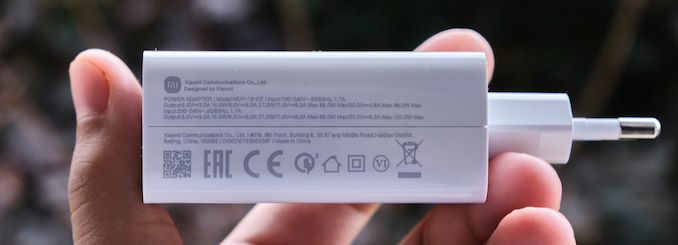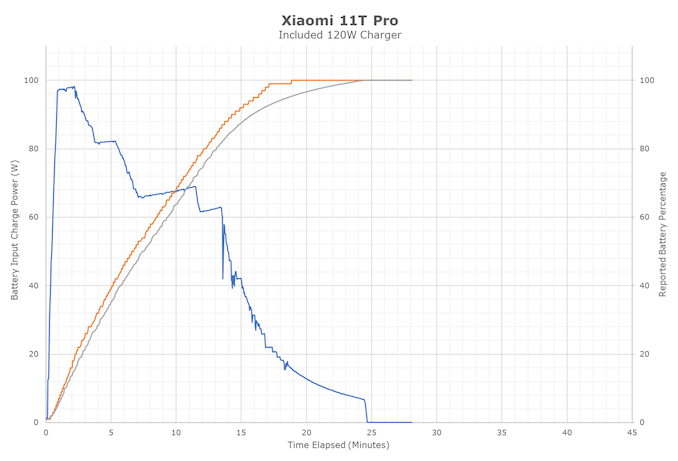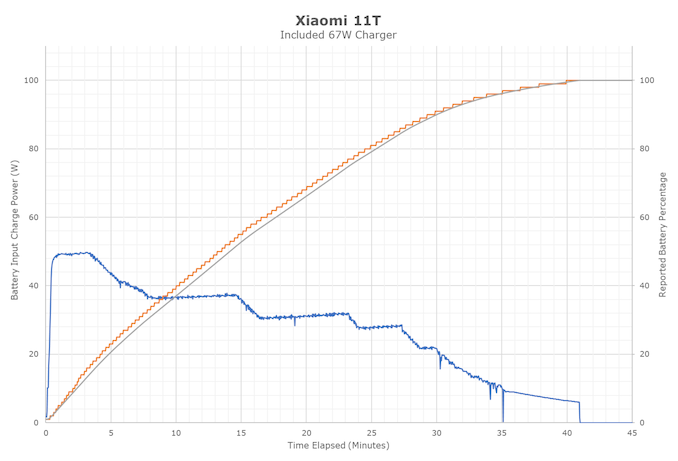The Xiaomi 11T & 11T Pro Review: Two Chips, With a Battery Focus
by Andrei Frumusanu on September 15, 2021 9:00 AM EST- Posted in
- Mobile
- Smartphones
- Xiaomi
- Xiaomi 11T
- Xiaomi 11T Pro
Fast Charging Note
Xiaomi is focusing the PR of the Mi 11T series on the fast-charging capabilities. Notably, the 11T Pro comes with a 120W fast charger:
It’s a USB-A connector on the power brick, and we can see that to achieve 120W the phone uses 20V and 6A transmission. The 6A is the rather special part as this requires a special thicker cable that’s included – otherwise any other generic cable will not allow to these kinds of power levels.
In terms of charging, we can see that the actual charge power into the phone reaches around 97W. The brick at the wall consumed up to 115W – keep that in mind when reading about fast-charging marketing claims, it’s mostly always the at the wall figure that’s being advertised.
The 97W figure only works up to around 20% charge, after which it goes down in steps to 80W to around 40%, 65-70W to 70%, and then gradually down to 6W. It’s notable that the phone doesn’t really do any trickle-charging at all. 0-100% happens in 25 minutes.
The regular 11T comes with a 67W charger, 20V at 3.25A. Peak power is around 49W in terms of charging the battery. It’s in general less aggressive, with 0-100% in 41 minutes.
Xiaomi made a few claims about the charging system a extract of the latest PR:
Xiaomi’s first smartphone to launch globally with the company's proprietary 120W Xiaomi HyperCharge technology. The industry-leading technology will enable a 100% charge in just 17 minutes*, giving creators more time to keep up with their creativity and minimize downtime by ensuring a full day use. This is achieved through innovative technologies such as dual charge pumps, dual-cell battery structure, MTW, Graphene application on Li-ion battery and Mi-FC technology. The safety of the battery is guaranteed by a TÜV Rheinland Safe Fast-Charge System Certification, 34 charging and battery safety features, real-time temperature monitoring and other measures
Notably, we had a few questions about the claims. First of all, the 17 minute claim is generally bogus – while yes, the phone does showcase a 100% status after around 17 minutes, which we reproduced, it actually doesn’t stop until around 25 minutes, when it reaches a true 100% figure. This is called fuzzy logic battery percentage reporting, and is generally used as a psychological incentive to not let your phone charge to 100% - almost every vendor out there does this, some to much worse discrepancies than showcased here.
We had sent Xiaomi a set of questions about 4 weeks ago, and gotten some answers only 2 days ago:
Q. Can we document the 34 safety features features?
A. Battery: High temperature charging/discharging protection, Low temperature charging/discharging protection, High current charging threshold management, Double overcharge protection, Overcurrent charging/discharging protection, Short circuit protection, Over-discharge protection, Battery safety encryption;
Circuit: Watch Dog, USB input over voltage protection, USB input under voltage protection, USB input overcurrent protection, Main charger Vout over voltage protection, Window under voltage protection, Window over voltage protection, Reverse current protection, Overheating shutdown protection, SMB VBAT protection, IBAT OCP protection, 2:1 input OVP protection, 2:1 output OVP protection, Battery monitoring system, Jeita charging protection, CC time out protection, PPS attach protection, PD authentication protection, Overheating NTC IC protection;
Charger: Short circuit protection, Overcurrent protection and overvoltage protection, Under voltage protection, Over-temperature protection, Cable encryption protection, Lightning protection, Electrostatic protection.
I questioned about the 34 charging features, and got an extensive list back as an answer. Generally, all these features are very much generic mechanisms that can be found in almost any smartphone, and are fundamental to any charge system, with only a few specific ones related to the serial battery charging being in any way special here.
Q. - What does up to 800 cycles mean? What are the criteria for this figure? Usually there's always some specification such as "retain up to 80% charge after 800 cycles".
- How were the charging cycles tested? What was the depth of charge of the battery (from which percentage start of charge to which percentage stop of charge) - are these partial of full charge cycles?
- How much more is the battery degraded compared to regular charging speeds? Does Xiaomi have any data to share in regards to battery health?
A. [...] The battery can obviously handle way more than just 800 cycles. You are absolutely right, the idea here is that it will maintain 80% of its capacity after 800 charging cycles, which is roughly two years before you'll notice any real difference. For most smartphones that number stands at only 500 cycles. The testing conditions are simple, we test the batteries under room temperature charging and discharging it thousands of times to make sure that the battery is able to retain most of its capacity.
In the initial PR a few weeks ago the 80% figure wasn’t mentioned, hence why I asked about the 800 cycles number.
In general, the issue we’ve been having with a lot of vendors is that we are having a lot of issue in getting anybody to actually specify the exact details of the test environment of these charge cycle tests and results.
In particular, I’m asking about the depth of charge of the test – a cycle can either be a full 0-100% charge, or it can also be 5 40-60% charges, in battery terminology, both of those count as a full cycle, however the 0-100% cycle will put significantly more stress and degrade the battery a lot more than the 5x 40-60% cycles.
Xiaomi here also isn’t very clear in their answer and didn’t address the question. Particularly, they talk about “most smartphones” only able to achieve 500 cycles, however, most smartphones don’t have 120W charging, so it can’t possibly be a valid comparison.
Xiaomi also notes that the battery is tested under “lab conditions” – this was also a topic of kerfuffle we’ve had with OPPO last year as the company kept producing questionable test results without any context of test methodology.
Usually, these battery stress tests are done via industrial battery charge/discharge capacity testers, meaning they are testing merely the battery cell, outside of the phone - a very important distinction compared to actual phone charge cycle stress testing.
Q Follow-up. - Can I get a clarification as whether this means that the batteries are being tested externally, outside of the phone, or if this means that the phone itself is being charged and discharged with the 120W system?.
I followed-up with the above question for clarification. This was also a stickling point with OPPO last year, as they would refuse to answer that the advertised charge cycles and capacity retention was actually tested with the advertised fast-charging system. I haven’t had a response from Xiaomi yet on the matter, however this was extremely close to the embargo time, I'll make sure to follow up if they do respond.
Q. For the TÜV certification - we've had similar claims from other OEMs, but the issue was that the certification doesn't have any public test methodology documented, nor are the exact results ever published. It is our understanding that this certification only essentially checks that the device doesn't result in any hazardous situation, but doesn't test things like battery health. Any more information is helpful."
A.Correct, the TÜV and other battery safety certifications are mainly focused on battery safety, and not on battery health.
However, at Xiaomi we use laboratory cycle verification, third-party laboratory tests, and ORT verification methods to ensure that the battery cycle life meets the highest standards.
Finally, I asked about clarification about the TÜV certifications. This was also a stress point in an interaction with OPPO last year, as they were trying to portray that the TÜV certification actually is testing battery degradation. Documents sent to me at the time were clear that they were completely unrelated to the fast-charge system.
Xiaomi deserves credit here to properly dismissing that notion and confirming that the TÜV certification is only related to safety – as in, they test that the charger or phone don’t blow up. Battery health and degradation is unrelated to the (non-public) test-procedures and certification.
Unfortunately, it’s been extremely hard to get a clear non-evasive answer from any vendors out there that promotes such extreme fast-charging systems. Xiaomi here also wasn’t able to produce any kind of convincing evidence that would argument that the 120W charging system doesn’t notably impact battery degradation.
We’re in the process of writing up a more dedicated and general fast-charging article that focuses on real data, and the actual latest science on fast charging. There is an incredible amount of misinformation, misconceptions, and outright falsehoods that are floating out there that we want to address.













41 Comments
View All Comments
beginner99 - Thursday, September 16, 2021 - link
Hence you should disable fast charging and only enable it when your really need it. Plus not go below 20% too often and not leave it plugged in at 100% overnight.philehidiot - Thursday, September 16, 2021 - link
Myself I have a balance between battery and lifestyle. I'm not rearranging my life around battery longevity and I've a local phone shop that does reasonably priced battery swaps. You lose waterproofing, though. I slow charge with a slow wireless charger overnight (to preserve the USB port which is a known weakness on my phone) and have "fast cable charging" disabled. So when I go on holiday, I take a normal wired charger and the super fast one. The super fast cable charging is enabled but there's no way of mixing it up as it's the only time I ever use that charger and I have to consciously get it. When you're in a rush, the last thing you want to do is mess around with charging options.It's not the most optimal solution for battery life, but I also bought a phone with a battery that would easily last a day and a half when I got it, so there is room to drop before it really impacts my routine.
I'll be very interested to see what this article has to say on the effect of fast charging on battery life. It's infuriating that people just aren't aware of the problems to the point that they'll actively challenge something that has been well established for decades - fast charging repeatedly damages batteries.
timecop1818 - Wednesday, September 15, 2021 - link
xiaomi makes a lot of USB power banks, so they should have experience with high charge/discharge battery cellsssdj - Thursday, September 16, 2021 - link
Xiaomi has a share in sunwoda, world's leading battery manufacturer on par with coslight.abufrejoval - Wednesday, September 15, 2021 - link
Well, it is becoming more and more difficult to achieve the miracles vendors want to sell and consumers want to brag about...But will consumers be unhappy with these devices, even when they are throttled to where they no longer burn their fingers (and the battery)? Probably not.
The main message for me is: Little benefit from new devices in terms of performance.
Limited battery life time, ever more fragile devices and limited software support unfortunately won't let us just keep our existing phones until things get interesting again.
GC2:CS - Wednesday, September 15, 2021 - link
Well thanks for your work an article on those FTL charging methods would be greatly appreciated.I do have a suspicion that something is wrong with "charges in 15 minutes and 120W in phone thing" when the basics are still lithium ions and cobalt oxide housing. They do not like high currents and high temperatures. And nobody talks about negatives. All I see is fanboys screaming "ur phone charges slower than a snail !"
So a thorough deep dive would be appreciated. Should I charge my notebook at 5W then ?
dragosmp - Wednesday, September 15, 2021 - link
Probably not at 5, but not at 120W either. For every battery chemistry and build quality there is a "maximum" charging speed for which there is no heat accumulation and no separator damage. If it's a "power" cell, aka a cell with a thinner and more permeable separator, then you can charge at higher power, but you get less Wh per volume. Power cells also tend to get higher self-discharge. At 5000mAh, so 5Ah, for an average 3.8V, 1C charging is 18W. 18W is surely safe, and probably somwere between 18 and 36W is safe too below 80% SoC. For more than that, it depends on the cell, heatsink/phone and charging curve - which is why I'm with Andrei on testing the battery inside the phone, as opposed to on a table with open airflow and maybe too keeping temps in check.Wrs - Wednesday, September 15, 2021 - link
There is already so much one can do with lithium and cobalt (or manganese sometimes).. what it boils down to is how good the design is and how well it's manufactured. Remember years back when we worried about whether 15W quick charging would lead to shortened lifespan compared to 5W charging? You could say back then designs were less advanced - production methods were not as refined, and the product has to be perfect btw, one mistake and a fire erupts in someone's pocket.I'm of course curious about how much degradation happens at 120w peaks compared to 15 or 25w. Someone will have to test that long-term. And then we'll have to ask whether that's significant or practically meaningful. Degradation is not really a fixed percentage; it's more like an added resistor to the battery. Draw high testing current and you'll see much higher % aging than if you draw low current. All that is relative to battery size. That's why Apple had that "fiasco" with performance throttling on older iPhones. Their battery designs tend to be smaller and more conservative (less cutting-edge). I will say I appreciate seeing a contrasting manufacturer who keeps pushing the edge - all this research prepares us for what we might see as standard tomorrow.
NextGen_Gamer - Wednesday, September 15, 2021 - link
Small (but funny typo): after making a point of talking about how Xiaomi has dropped the Mi branding from the 11T series, you then proceed to call them just that in the spec comparison table right afterwards hahaAndrei Frumusanu - Wednesday, September 15, 2021 - link
Thanks, I had written the header table before Xiaomi emphasised the Mi removal.